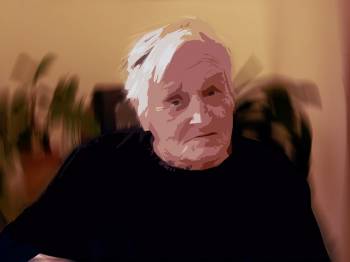Parkinson's Disease
 Parkinson's disease ia a chronic, progressive degenerative disorder of the nervous system. Its average age of onset is in the early or mid 60's, but in a minority, can occur much earlier (Young-onset Parkinson's disease and Juvenile-onset Parkinson's disease).
Parkinson's disease ia a chronic, progressive degenerative disorder of the nervous system. Its average age of onset is in the early or mid 60's, but in a minority, can occur much earlier (Young-onset Parkinson's disease and Juvenile-onset Parkinson's disease).
Parkinson's Disease occurs when the nerve cells in the brain beak down and fail to produce enough dopamine, the chemical responsible for sending signals to the part of the brain which controls movement. On autopsy, the main pathological finding associated with Parkinson's is the loss of pigmented dopaminergic cells in the pars compacta of the substantia nigra, of the mid-brain.
Patients who suffer from Parkinson's Disease often have problems with balance and experience tremors which may affect the arms, legs and hands. Their muscles are stiff thus making movement slow and difficult. As Parkinson's is a progressive disease, the severity of the symptoms would vary with stage of the disease.
In the early stages of the disease, patients with Parkinson's disease usually present with tremors (usually more pronounced on one side), slowness of movements and muscle stiffness. In the later stages, other symptoms may surface, including frequent falls, sleep disturbances, giddiness, erectile dysfunction and cognitive abnormalities
What are the Symptoms of Parkinson's Disease?
The kind and severity of symptoms will depend on the stage of the disease. There is also variation in the presentation of the disease in different individuals.
Common symptoms of Parkinson's disease include:
1. Tremors:
Tremors refer to the involuntary shaking of the hand, arm or leg. In Parkinson's disease, the tremors tend to be worse on one side, and typically occurs at rest and subsides when the person moves the affected limb (as opposed to "movement tremors" found in other brain conditions, such as cerebellar diseases). When observing the fingers of someone with Parkinson's, a "pill-rolling" rest tremor is often seen. This is found in up to 80-90% of patients with Parkinson's disease.
2. Muscle rigidity:
The muscles tend to become stiff and hard in Parkinson's. This contributes to the reduced arm swing typically seen in the gait of someone with Parkinson's.
3. Bradykinesia:
This refers to generalized slow movements. Patients with Parkinson's disease tend to take a long time to get out off a chair, or get out of bed.
4. Gait Disturbances and Postural Instability:
Patients with Parkinson's in the more advanced stages, have the classical stooped, shuffling gait. They take very small, shuffling steps, are slightly stooped forward and have reduced swinging of the arms. Making turns and stopping can be slow and difficult. These balance and posture problems also make Parkinson's patients more prone to falls.
5. Weakness of the Throat and Face Muscles:
Weakness of the muscles of the face and throat make talking and swallowing difficult. The speech of someone with Parkinson's may be soft, slow and monotonous. There is often a expressionless, fixed look on the face, often referred to as a "Mask-like facies" or "Parkinson's mask". They are also more prone to drooling and choking when eating.
Diagnosis of Parkinson's Disease:
There is unfortunately, no reliable diagnostic test for Parkinson's disease, so your doctor would have to make the diagnosis based on the presence of features characteristic of Parkinson's, only after having excluded alternative causes.
Your doctor will conduct a thorough clinical interview and perform a detailed neurological and physical examination. Cognitive tests are also an essential part of the assessment. There is a set of diagnostic criteria which your doctor will use, but even with this, the diagnostic accuracy is around 75 to 90%. Definitive diagnosis is only possible at autopy.
Sometimes, doctors order tests to rule out other conditions which may mimic Parkinson's disease.
Some of these tests may include:
• Blood tests e.g. to rule out hypothyroidism
• CT scan MRI of the brain: to rule out strokes or brain tumours
Treatment of Parkinson's Disease:
At present, there is no known treatment to stop or reverse the degeneration of nerve cells responsible for Parkinson's disease. Treatment is thus directed at relieving troubling symptoms associated with the disease. The decision to start treatment as well as the type and dose of treatment used would differ according to age, living situation, lifestyle, occupation etc. As the condition progresses, adjustments to treatment type and dosages may be required to balance symptom control, side effects and treatment costs.
MEDICATION commonly used:
• Levodopa
• Dopamine Agonists
• Anticholinergic agents
• Amantadine
• Catechol-O-methyltransferease (COMT) inhibitors
• Monoamine oxidase-B Inhibitors
• Drugs to treat depression, dementia, orthostatic hypotension, erectile dysfunction etc.
SURGERY:
Surgery for the treatment of Parkinson's disease is recognized as being a valuable addition to medical therapy. Surgery is directed at the part of the brain known as the basal ganglia, either in the form of placement of stimulating electrodes (Deep Brain Stimulation) or destruction by coagulation. Surgery has been found to be particularly useful in the control of the motor (movement) complications of the disease.
Further Reading
The article above is meant to provide general information and does not replace a doctor's consultation.
Please see your doctor for professional advice.
